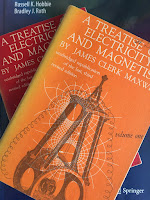 |
| A Treatise on Electricity and Magnetism, by James Clerk Maxwell. |
In this issue we celebrate the first expression of those equations by Scottish physicist Maxwell in the Philosophical Magazine 150 years ago. There he drew together several strands of understanding about the behaviour of electricity, of magnetism, of light, and of the ways in which these fundamental aspects of nature behave in matter. As Albert Einstein remarked, “so bold was the leap” of this work that it took decades for physicists to grasp its full significance. And although it was a wonderful expression of science at its purest, it was forged in the thoroughly practical culture of intellects at that time.Russ Hobbie and I mention Maxwell’s equations in the 4th edition of Intermediate Physics for Medicine and Biology. We added a new homework problem to the 4th edition in Chapter 8 (Biomagnetism).
Problem 22 Write down in differential form (a) the Faraday induction law, (b) Ampere’s law including the displacement current term, (c) Gauss’s law, and (d) Eq. 8.7. … These four equations together constitute “Maxwell’s equations.” Together with the Lorentz force law (Eq. 8.2), Maxwell’s equations summarize all of electricity and magnetism.All four of Maxwell’s equations are discussed in our book. Section 6.3 is dedicated to Gauss’s law, governing the electric field produced by a collection of charges, and we analyze the usual suspects: a line of charge and a charged sheet. Ampere’s law appears in Section 8.2 (The Magnetic Field of a Moving Charge or Current), and—in one of my favorite homework problems—we show in Problem 13 of Chapter 8 how “one can obtain a very different physical picture of the source of a magnetic field using the Biot Savart law than one gets using Ampere’s law, even though the field is the same.” Faraday’s law is presented in Section 8.6 on Electromagnetic Induction, followed by a discussion of magnetic stimulation of the brain. Even Gauss’s law for a magnetic field (Eq. 8.7, stating that the magnetic field has no divergence) is introduced. Maxwell’s great insight was to add the displacement current term to Ampere’s law. We show how the charging of a capacitor implies the existence of this additional term on page 207, and explore its role in biomagnetism (slight).
 |
| The Feynman Lectures on Physics, by Richard Feynman. |
It was not customary in Maxwell’s time to think in terms of abstract fields. Maxwell discussed his ideas in terms of a model in which the vacuum was like an elastic solid. He also tried to explain the meaning of his new equation in terms of the mechanical model. There was much reluctance to accept his theory, first because of the model, and second because there was at first no experimental justification. Today, we understand better that what counts are the equations themselves and not the model used to get them. We may only question whether the equations are true or false. This is answered by doing experiments, and untold numbers of experiments have confirmed Maxwell’s equations. If we take away the scaffolding he used to build it, we find that Maxwell’s beautiful edifice stands on its own. He brought together all of the laws of electricity and magnetism and made one complete and beautiful theory.Anyone with a historical bent may want to read Maxwell’s original papers and accompanying commentary in Maxwell on the Electromagnetic Field: a Guided Study, by Thomas Simpson. The book contains a detailed analysis of Maxwell’s papers, including “On the Physical Lines of Force,” which is the publication we celebrate this month. Simpson’s book is the best place I know of to learn about the “scaffolding” Maxwell used to build his theory.
I will close with one of my favorite quotes, again from The Feynman Lectures. At the end of his first chapter introducing electromagnetism, Feynman writes
From a long view of the history of mankind—seen from, say, ten thousand years from now—there can be little doubt that the most significant event of the 19th century will be judged as Maxwell’s discovery of the laws of electrodynamics. The American Civil War will pale into provincial insignificance in comparison with this important scientific event of the same decade.



